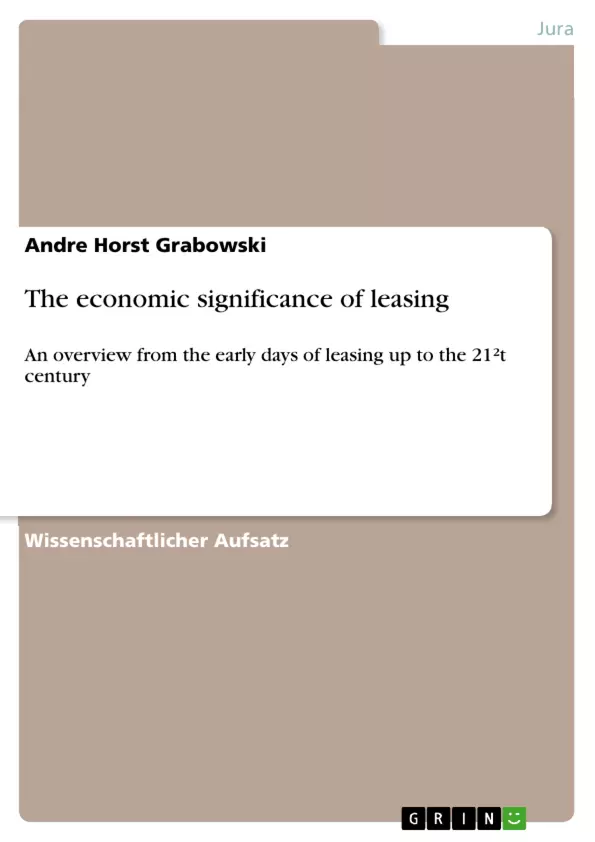1. Introduction
These days, leasing is usually understood as a modern form of financing of
various assets, both in the commercial and the private sector. Leases have now
become an integral part of economic life. With their multiple creative
possibilities and variations, leases are an equitable alternative to buying and
renting for companies.
The diversity of different forms of leasing, and the fact that there is no uniform
lease contract as a reference, results in lease accounting being one of the most
difficult areas of accounting under almost all jurisdictions. [1] This diversity leads
to an accounting system for leasing business with different possibilities to allocate
positions in the P & L and balance sheet. Due to the lack of specific rules, leasing
accounting is mostly based on general accounting principles. [2] In Germany,
relevant tax decrees have impact on the local accounting. Leases are, in principle,
not fixed on legal contract types, and this allows temporary grant of use and
utilization of liquidity-friendly financing alternatives in the balance-sheet. Since
most major accounting systems presuppose exclusion of pending transactions
from the balance sheet, [3] companies used contracts for grant of use, such as lease,
deliberately to influence the accounting. For example, sale and leaseback
transactions are used to reduce the balance-sheet debt, though the physical
property mapping has not changed. [4]
The current lease accounting under IFRS 17 of the IASB is to be understood as a
reaction to the existing situation in the various accounting systems. The aim of
the standard setter was to capture the major part of the grant of use in the balance
sheet. All postings, which change the asset allocation similar to an investment,
should also be accounted as such. [5] The concept of economic ownership divides
any grant of use in leasing into two classes. The finance leases which, simply put,
means all long-term and investment-like grants of use, and operating leases,
which are any other grants of use. This was still not sufficient for the standard
setters, in particular against the backdrop of the various forms of expenses, and
due to growing discussions at national and international levels about renewal of the lease accounting. In particular, the Chairman of the IASB, Sir David Tweedie
and the IASB member Warren McGregor found the current lease accounting a
thorn in their side.
[...]
Inhaltsverzeichnis
- Introduction
- Definition of Lease
- Historical Development
- Various Forms of Leasing
- Overview
- Basic Types of Leasing
- Full-Amortization Contracts
- Partial-Amortization Contract
- Distinction by Asset Type
- Equipment and Real Estate Leasing
- Other Distinctions
- Corporation-Leasing
- Consumer Goods Leasing
- Equipment Leasing and Plant Leasing
- So-called Zero Leasing
- Sale and Leaseback Leasing
- Second-hand Leasing
- Full-Service Leasing
- Big Ticket Leasing
- Cross-border Leasing
- Municipal Leasing
- Fund Leasing
- Distinction between Operating Leasing, Finance Leasing and Hire Purchase
- Operating Leasing
- Finance Leasing
- Hire purchase
- The Economic Significance of Leasing
Zielsetzung und Themenschwerpunkte
Diese Arbeit untersucht die historische Entwicklung und die verschiedenen Formen des Leasings, mit besonderem Fokus auf die Unterscheidung nach Anlagegütern und die Abgrenzung zwischen Operating- und Finanzleasing. Ziel ist es, die wirtschaftliche Bedeutung des Leasings im Kontext der heutigen Wirtschaft aufzuzeigen.
- Historische Entwicklung des Leasings
- Verschiedene Formen des Leasings
- Abgrenzung zwischen Operating- und Finanzleasing
- Wirtschaftliche Bedeutung des Leasings
- Entwicklung des Leasings im 21. Jahrhundert
Zusammenfassung der Kapitel
Die Einleitung stellt das Leasing als eine moderne Finanzierungsform im gewerblichen und privaten Sektor vor und beleuchtet die Herausforderungen der Leasingbilanzierung aufgrund der Vielfalt an Leasingformen. Kapitel 2 definiert den Begriff „Leasing“ als die Überlassung eines Gutes durch den Leasinggeber (Vermieter) an den Leasingnehmer (Mieter) und beschreibt die Unterschiede zwischen Finanzleasing und Operating-Leasing.
Kapitel 3 beleuchtet die historische Entwicklung des Leasings, beginnend mit frühen Formen wie der Vermietung von Ochsen im babylonischen Reich bis hin zur Entwicklung des modernen Leasings im 19. Jahrhundert. Die Bedeutung des Leasings für die Wirtschaft und die verschiedenen Formen des Leasings werden in den folgenden Kapiteln behandelt.
Schlüsselwörter
Leasing, Finanzierungsform, Operating-Leasing, Finanzleasing, historische Entwicklung, Wirtschaftliche Bedeutung, Anlagegüter, Bilanzierung, IFRS 17, McGregor Paper, Rechtliche Rahmenbedingungen.
- Quote paper
- Rechtsanwalt Andre Horst Grabowski (Author), 2011, The economic significance of leasing, Munich, GRIN Verlag, https://www.grin.com/document/168398



